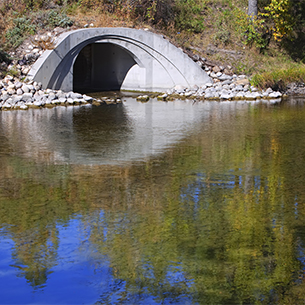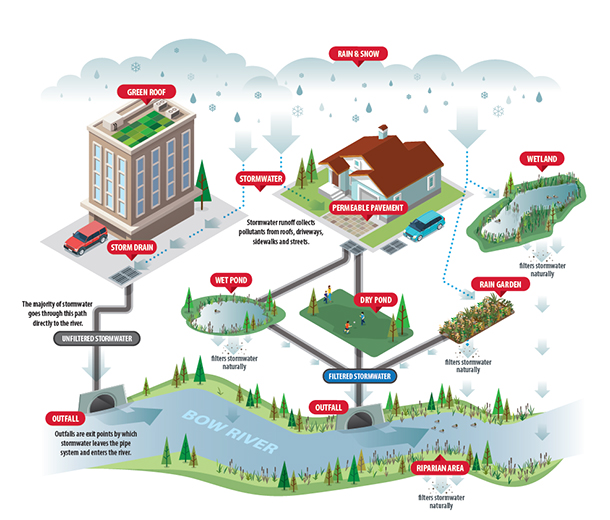Stormwater management
Stormwater is the water from rainstorms or melting snow that goes into the storm drains in the road through an underground pipe system to our rivers.
These pipes start out small and get larger the closer you are to the river. They direct stormwater to the river by the way of gravity.
Stormwater services
Print guide for stormwater information
Protecting our stormwater system
Every time it rains or snow melts, our streets, driveways, parking lots and lawns get a bath. Dirt, oil, gasoline, garbage, animal droppings and chemicals such as fertilizers and pesticides are washed into storm drains.
Stormwater and the pollutants in it flow into our rivers through outfalls – the concrete drains you see along the river. This can affect the health of our streams, rivers and the land surrounding them, as well as the health of the wildlife and fish that rely on them.
Help protect our rivers with these tips:
- Point downspouts toward lawns and gardens
- Use a rain barrel with your downspouts
- Limit the use of fertilizers and pesticides
- Sweep up debris from your garage and driveway instead of washing it away
- Wash your vehicle at a car wash
- Pick up after your pet at home and elsewhere
- Never pour anything down the storm drain
Our stormwater management system
As our city has grown to over 1.2 million people on a land area of over 850 square kilometers, the landscape has been replaced by many hard surfaces like roads, parking lots and buildings. When rainfall and snow-melt runs off hard surfaces, stormwater reaches waterways faster, in greater volumes and with more pollution.
Our stormwater system enters into the Bow and Elbow rivers without going through a treatment plant, so we need to ensure the water draining into it is clean. We are also working to reduce pollution entering our rivers from stormwater, as well as manage the amount of water which can result from storms and runoff.
Our stormwater management system reduces the impact of flooding, pollution and stream erosion. The practices below also improve the quality and decrease the volume of stormwater entering our waterways.
Storm drains
Storm drains (or catch basins) are the main way stormwater gets into the underground pipe system. There are about 60,000 storm drains in Calgary which drain water off sidewalks, streets and roads.
The metal grates that can be seen at the edge of the road are only a portion of the catch basin structure. Under the sidewalk is a barrel that collects water. The barrel is attached to a pipe that allows the water to be whisked away, eventually into our rivers.
To learn more visit, Storm Drains in Calgary.
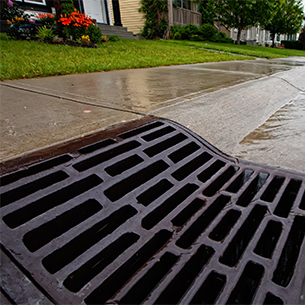
Wet and dry ponds
A dry pond is dry over 95 per cent of the time and can have playing fields in it. Dry ponds fill with water very quickly in heavy downpours, and can take as long as 24 hours to drain once the rain stops. Dry ponds are connected to stormwater infrastructure.
A wet pond (which includes storm ponds and constructed wetlands) captures and contains stormwater – for a while. Storm ponds slow down water long enough to settle out some of the sediments and pollutants, helping return cleaner water to our rivers and streams through the stormwater system. They are a critical piece of infrastructure that also help protect downstream communities from flooding. There are 200 storm ponds throughout the city.
To learn more, visit Stormwater Ponds in Calgary.
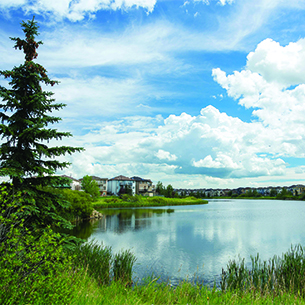
Low impact development
Engineered rain gardens, green roofs and permeable pavements are landscaping and design practices that work with nature to manage stormwater runoff where it falls. They slow water down, spread it out and allow it to soak in.
Learn more at Low Impact Development and Rain Gardens in Calgary.
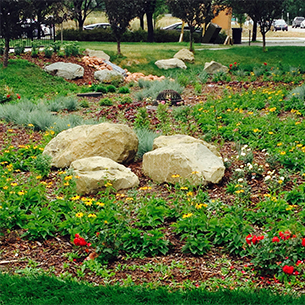
Wetlands
A wetland is an area of land that is saturated with water either permanently or seasonally. It contains plants and the water is quite shallow before a storm. A wetland is not directly connected to Calgary’s stormwater system.
Learn more at Conserving Our Wetlands.
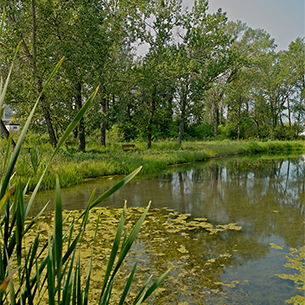
Outfalls
Outfalls are exit points by which storm water leaves the pipe system and enters the river. There are more than 800 outfalls located across Calgary.
In winter, ice can build up and force water from the river, and into the storm mains and surrounding communities. The outfall gates prevent this from happening. The gates are closed and monitored daily during winter months (November to April) because the ice pack on the river can change dramatically in a short period of time.
If the level of stormwater is significant, the gates are opened and the water is released. The gates are then immediately closed again. During summer months (May to October), the gates are fully open; however, they are monitored during this time and closed during high river flows to prevent water flowing back into the community.
